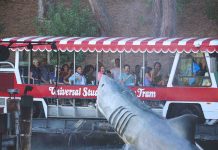In 2006, John Murdy – Creative Director for Halloween Horror Nights – was tasked with bringing the spectacular Halloween event back to Universal Studios Hollywood after a six-year hiatus. Now with twelve consecutive years under his belt, Murdy and his team have turned Halloween Horror Nights into the go-to haunt event on the west coast.
John Murdy was gracious enough to do an interview with Inside Universal, talking about the creative process and the level of teamwork involved in executing a haunt event in a theme park that coexists with a fully-operational movie studio. With other similar Halloween attractions within the Southern California area, Murdy tasks himself with the challenge for Halloween Horror Nights to be relevant. “(Southern California) is the most competitive place in the world. There is no other place that can even match it.” Murdy explains.
“…When our performers see me walking through a maze; it’s a sense of pride if they can scare me.”
Guests of any Halloween Horror Nights event can always appreciate the effort and energy that goes into creating a haunt experience; but as fans we aren’t readily aware how the creative process never ends. After spending hundreds of hours developing the mazes and scare zones during pre-production, the team changes focus toward quality of the experience, “I’m actually looking at it very technically, I’m looking at every single performer to ensure they’re doing what we want them to do and they’re doing it on the right cycle. Because with a live event instead of a ride, everything comes down to a performers timing; so we have an old adage from Halloween Horror Nights with our performers where ‘it’s a new show every ten seconds’. That’s the average length of a person to walk-through a scene; but of course, some scenes are shorter…and some are longer. But what we’re trying to communicate to our performers is that the mentality you have to get into if you’re going to be a scare actor for Halloween Horror Nights. You have to be firing every ten seconds or five seconds, whenever we tell you. We’re walking the maze. So a lot of the times, I’m checking cycle times to see a scare. I’m looking at the lighting, listening to the audio, if there’s special effects involved, I’m looking at that. It’s a very technical experience versus what the guest experiences, but at the same time, when our performers see me walking through a maze; it’s a sense of pride if they can scare me.”
Universal Studios Hollywood hosts a dress rehearsal event to allow for each performer to get a chance to focus on their roles. Murdy likes to take this time to get the cast focused “I’m kind of doing two things. I’m going through all of the mazes, the scare zones, and the Terror Tram, but I’m also going backstage and talking to the cast member, making sure everyone is good and excited; because being a scare actor in this event is a very physical job, so I feel like I need to be their cheerleader.”
Audiences have changed the experience of creating Horror Nights. Mazes require more than just scares now; with some utilizing puppetry, animatronics, projections, and set design in recent years. When asked which mazes he found to be the most difficult to bring to a life, he mentions “Probably The Shining“.
Murdy continues, “very much like the movies that were made in the seventies and eighties, it’s a slow-burn movie. It’s kind of a lot like The Exorcist. A couple of years ago when we found out we were going to do The Exorcist, I was thrilled, because I’ve been wanting to do it for years. (Later) a sense of panic set in, because I realized I’ve wanted to do it all this time and never really thought about how. That movie and The Shining share a lot of common things. When you really boil the movie down, it’s about an 11-year-old girl who never gets out of bed. Every scene that’s famous in that movie takes place in that bedroom. I remember sitting down with my art director, Chris Williams, when we first designed the maze – I said, ‘Okay, I think there are going to be four or five bedrooms in this maze’ and we had to figure out what was going to be the connective tissue that would make it work as a maze. And for The Exorcist that was Pazuzu, the subliminal messages of the demon you see in the movie. So I wanted to convey the same feeling I had when I was a kid to the maze itself as the transitional devices to get us from bedroom to bedroom. The Shining presents a similar, but even greater challenge, that much of the film is psychological horror. When you really look at some of the scariest scenes in The Shining, they don’t necessarily involve somebody jumping out and going, “Boo!”. Then there’s the challenge of the Overlook Hotel. I’m like – ‘how are we going to do this?’ With the Overlook (Hotel), that aerial shot you get in the beginning of the movie, it’s beyond massive. There’s no way to translate that to a façade. Even if you tried to scale it, it would look silly. So first and foremost, we had to look at how to get you into The Shining, (which) quickly became the hedge maze. And how do we convey the psychological horror that pretty much resisted ourselves that every haunt designer might (require) a scare in every scene. In fact, if you really look at this maze, there are a lot of scenes where there are no performers at all. The first scene, Redrum Door, there are no performers. The second scene is the Colorado Room, where we see a projection of Jack typing, there are no performers. The Grady twins and the elevator scene, no performers. In some ways, we took the same approach we took (with) The Exorcist where all of the encounters with Jack Torrance with the axe are happening mostly as transitions. Then we’re letting the visuals that Kubrick created speak for themselves.”
Murdy also acknowldeges the difficulities in taking films as iconic as The Exorcist and The Shining and letting the scene speak for itself, when not everyone may have seen those films.
Murdy says, “Horror movie styles have changed. They don’t make horror movies like that very often anymore. With audiences there have been some generations that have never seen a movie like that before. It’s a really delicate balance between being faithful and authentic to these iconic films and putting in all of the details that we know fans of these movies are going to want to see and also creating a compelling haunted attraction that will work as a live experience. And that’s always the challenge in working with these iconic properties.”
La Llorona presented a different type of obstacle for Murdy in 2011. Murdy was not familiar with the story of the La Llorona legend and soon realized he had be extremely careful and authentic. When asked if the La Llorona imagery could ever go too far, he says “No, I don’t think so; but the scene that was walking that line was a scene where you crossed a river and the kids were floating in the river. I’m a dad now, but I wasn’t back then, and that scene is terrifying to me. So I was learning the story and since I was the creative director (who was) charged with bringing it to life as a haunted attraction, (I) wanted to be very much as authentic as possible.”
“It’s a really delicate balance between being faithful and authentic to these iconic films and putting in all of the details that we know fans of these movies are going to want to see and also creating a compelling haunted attraction that will work as a live experience”
For Universal Studios Hollywood, 2017 has more mazes than ever, which increases the logistical challenge of what spaces are available at the studio. On a property which is unlike most theme parks, where the park is divided in multiple areas and levels, Murdy says, “It is always a constant challenge to find locations. Over the years, we’ve had locations, we’ve lost locations and we get new locations. Once you know where you’re going to be, which has changed many, many times over the years, then you have to look at the slate of properties and figure out which ones are best suited for each location. But it isn’t solely a creative decision. You have to think about it from a theme park operational sense. How do we disperse people from the top deck of the park to the lower deck of the park? To the Terror Tram? Into the Backlot? Into the metro area of the Backlot? You don’t want all of your most popular properties all in one place, you want to spread them out so you even out the distribution of guests, which is purely theme park operations. So, it’s a balance of best creative choice and how best to pace the event so that the main marketed properties are evenly dispersed throughout the event. It’s tough.”
Even after creating one of the more successful haunt events in the country, Murdy remains grounded with the understanding that the reason it is successful is because of the scare actors, team members, operations and most importantly the fans, “We’ve been blessed with really loyal fans who’ve supported this event year after year. This event every single year tops itself – for twelve straight years it’s done that, and that’s almost unheard of; but I think the reason it does, the people at all levels, from myself to every performer in this event are just hungry, we’re constantly, constantly trying to do better work if we can. And that’s always the way we approach it.”
“The people at all levels, from myself to every performer in this event are just hungry, we’re constantly, constantly trying to do better work if we can.”
Asking Murdy what’s challenges lie beyond 2017, he states it’s the same challenge that they’ve had since 2006.
“In 2006, when we were first bringing Halloween Horror Nights back, the goal was to do a 2007. We had no idea if we’d make it past 2006, because it hadn’t been back in this park in a number of years and this is the most competitive place in the world. There is no other place that can even match it.”
Murdy continues, “What we’re trying to do is not get complacent. It’s really easy to get complacent when you’re successful.”
“I feel like it’s my responsibility to make those dreams, or nightmares, come true.”
Coming away from speaking with John Murdy, it’s easy to see someone who is passionate about his work and respectful of the creative and production process on all levels. Being authentic and genuine, with a product that has so many difficult challenges, brings a sense of respect to the final product. We’d like to thank John Murdy for taking the time out of his busy schedule to speak with Inside Universal. It is always a pleasure to get an inside perspective of the development and creativity of our favorite world class experiences.
Halloween Horror Nights Hollywood 2017 continues on select nights through November 4 at Universal Studios Hollywood.









